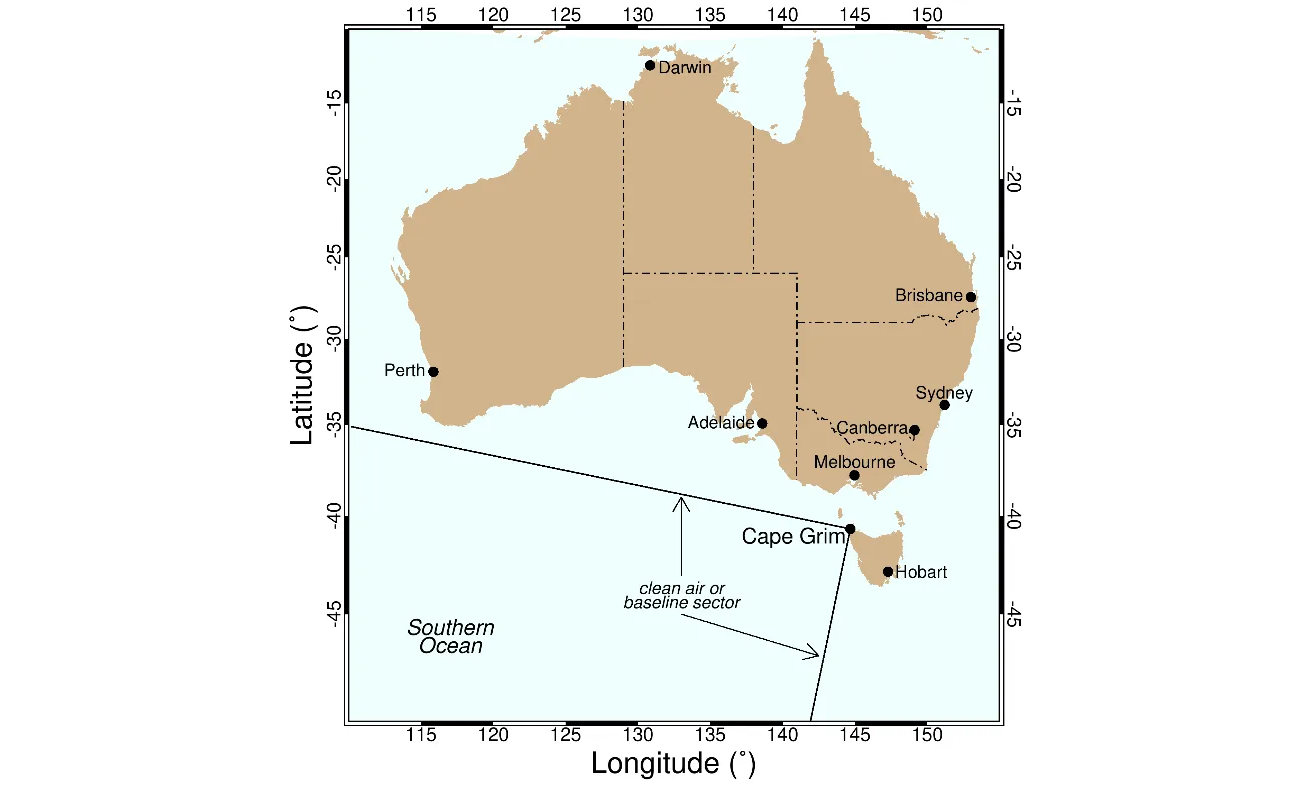GEOGRAPHIC EXTREMES SOCIETY
AUSTRALIAN RECORDS
Cleanest Air
Throughout Australia Cape Grim has the reputation of having the cleanest air. Was this true, and from where did the claim arise. For the last couple of decades, Cape Grim has been lauded as having the cleanest air in the world. Not letting a marketing opportunity go by, primary producers have taken this further by marketing Cape Grim Water as the world’s purest; Cape Grim Vodka is supposedly the purest vodka on the market; Cape Grim Beef is the best beef. And Cape Grim air-in-a-bottle? Yep, you guessed it, the world’s cleanest air. We needed to examine the extreme claim – if only because they sounded too good to be true.
Cape Grim owes its clean air reputation to its housing of the Bureau of Meteorology’s Baseline Air Pollution Station. ‘Baseline air’ is atmospheric air taken from a location with no industrial or agricultural activities upwind to pollute the sample. The original station in the 1970s saw the staff working in a small, old caravan donated by NASA after supporting Tidbinbillas role in the Apollo Moon missions. The government recognised the importance of this work, and a larger demountable replaced the caravan before establishing a permanent station at Cape Grim in 1980. As I stood on Victory Hill taking photos of the station, the site appeared to resemble a covert military facility with its giant towers bristling with satellite dishes.
Australia punches above its weight in researching and analysing the chemical composition of the atmosphere. The CSIRO’s Aspendale and Cape Grim facilities are part of the world’s most comprehensive non-CO2 Green House Gas measurement programs ever undertaken for the atmosphere. They were the brainchild of Paul Fraser, who I regard as one of the most forward-thinking scientists Australia has produced.
Paul Fraser postulated the need for a catalogue of air samples to enable climate scientists to compare changes in atmospheric chemistry after it became apparent there was a lot of historical information missing. A CSIRO team began the search for a permanent site for Paul Fraser’s big plan, to capture a sample of atmospheric gases and make a continuous library of these gases which future scientists could analyse. Fraser’s proposal was to draw 1,000 litres of pristine air into sterile stainless-steel tanks as part of a three-monthly air archive. Tasmania was the logical option, so they set about finding the cleanest air possible, and the Cape Grim facility was opened a few years later.

Cape Grim. Cleanest Air in the World?. Image: CSIRO
The Cape Grim Air Archive was designed not only to hold samples of air for future generations of researchers but also to monitor baseline gases and chemicals. It’s not only chemicals but also haze-forming particulate pollution which affects much of the world’s atmosphere. PM2.5 relates to fine particulate matter that is 2.5 microns or less. Many countries are choking on PM2.5 in the air, with an estimated 5.5 million people dying from this type of pollution worldwide every year. PM2.5 is small enough to lodge into human lungs and has the potential to cause severe heart and lung disease. If Australians think this is a problem isolated to developing nations, they’re mistaken – one of the major causes of PM2.5 pollution is from bushfires. The summer of 2019/20 had pollution levels across extensive parts of Australia exceeding those of India and China.
The establishment of the Cape Grim facility was to sample baseline air. This is the air captured when the direction of the wind blows 190o to 280o, or roughly southerly to westerly winds. If the wind blows from any other direction, it’s not considered baseline air, but deemed to have come into contact with land surfaces. Unwanted wind direction happens more than the CSIRO would like. Baseline air parameters can’t include bushfire smoke streams from fires in southern Tasmania or hot winds which often blow in from mainland Australia, sometimes with accompanying dust storms.

Cape Grim baseline air vector. Image: CSIRO
As we have seen, marketing yourself as having the cleanest air in the world has become big business, and people invested in the Cape Grim clean air concept have taken it to a whole new level. But what is the claim of the cleanest air based upon? When I dug deeper into the history of the project, I was disappointed to discover that Cape Grim doesn’t even have the cleanest air in Tasmania, let alone the world.
Worldwide, there were three baseline air stations initially set up by the NASA teams, with Cape Grim being Australia’s contribution. The other two stations were in Hawaii and far northern Canada. Cape Grim’s claim as the cleanest air derives solely from the fact that its site recorded the least amount of PM2.5 in those early years of operation. Today over 30 stations are contributing to the global network to monitor the atmosphere, including two in Antarctica.
The claim also fails to live up to the hype, suffering dismally because the Cape Grim station halted measurements of PM2.5 two decades ago when some of their equipment malfunctioned and never replaced. The question remains, does Cape Grim have the cleanest air in Australia?
To my surprise, I learnt that Cape Grim wasn’t the CSIRO’s first choice for an Atmosphere Research Station to measure baseline air. In the mid-1970s, CSIRO spent a year inspecting sites and air-sampling on the ground and by aircraft. It was determined that a site at Honey Smith Hill near Cockle Creek, adjacent to the southern-most point of Tasmania, South East Cape, would be the best place to draw samples of baseline air from the Southern Ocean. The Honey Smith Hill site was minimally affected by mainland winds and dust storms. It also wasn’t as prone to receiving Tasmanian bushfire smoke and had a cleaner, yes, cleaner air than any other site the CSIRO tested. Not only was it cleaner, but the spectrum to sample the air was also much broader and was available for a far greater portion of the year than the current Cape Grim location.
In the end, it was economics which determined the location of the atmospheric research station. During the final stages of site selection, it was brought to the CSIRO’s attention that there was suitable vacant government land at Cape Grim where some old radio communication towers had become obsolete. The Cape Grim site won the day because it had a road already leading to the site and mains power was readily accessible, so but for the absence of a road and a power line, Cockle Creek in Tasmania’s south, would be laying claim to the ‘Cleanest Air in the World’.

Cockle Creek. Cleanest Air in the World? Image: Far South Tasmania
Clean Air Records
GES Record: Cleanest air in Australia – Cockle Creek. Near South East Cape. Tasmania. (Source: CSIRO Baseline publication 1977)
The Geographic Extremes Society welcomes any input as to the veracity of these records and we encourage everyone to contribute to these extreme records by contacting us to initiate the discussion
